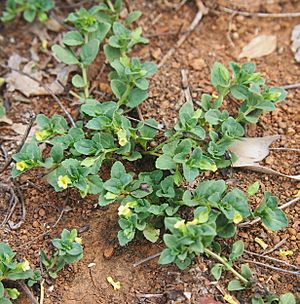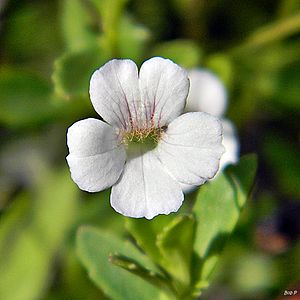Axilflower facts for kids
Quick facts for kids Axilflower |
|
|---|---|
 |
|
| Mecardonia procumbens | |
| Scientific classification |
|
| Kingdom: | Plantae |
| Clade: | Tracheophytes |
| Clade: | Angiosperms |
| Clade: | Eudicots |
| Clade: | Asterids |
| Order: | Lamiales |
| Family: | Plantaginaceae |
| Tribe: | Gratioleae |
| Genus: | Mecardonia Ruiz & Pav. |
| Species | |
|
Mecardonia acuminata |
|
Mecardonia (also called axilflower) is a group of small, low-growing plants. They belong to the plantain family, known as Plantaginaceae. Scientists have found and described 31 different types, or species, of Mecardonia. Out of these, 12 are officially recognized.
These plants mostly grow in South America and the southeastern United States. You can find them in places like Florida and Alabama. Some even grow as far north as Virginia. For example, five species are found in Argentina, and three are found in the U.S.
Contents
What Does Mecardonia Look Like?
Mecardonia plants are usually herbaceous. This means they have soft, green stems instead of woody ones. They are also procumbent, which means they grow along the ground. The plants are glabrous, meaning they have no hairs on their surface.
When these plants dry out, they often turn black. Their stems can be anywhere from 5 to 40 centimeters long. They have leaves that are shaped like an egg (ovate). These leaves are 7 to 25 millimeters long and 3 to 16 millimeters wide. The edges of the leaves are slightly toothed, which is called crenate. Each leaf has a small stem, called a petiole.
Mecardonia Flowers and Fruit
Mecardonia plants have single flowers that grow from the axil of the leaves. The axil is the angle between the leaf and the stem. Each flower sits on a stalk called a pedicel, which is 8 to 26 millimeters long. At the base of the pedicel, there are two small leaf-like parts called bibracteoles.
The flower has a five-lobed calyx, which are the green parts that protect the bud. These lobes are not all the same size. The flower also has a five-lobed corolla, which is the colorful part. It is usually 7 to 8 millimeters long. The flowers are yellow with purple at the center and have some hairs inside. Each flower has four fertile stamens, which are the parts that produce pollen.
After the flower, an egg-shaped fruit capsule grows. This capsule is 5 to 7 millimeters long. When it's ready, it splits open to release the seeds. The seeds are also egg-shaped and have a net-like pattern on them.
How Mecardonia Got Its Name
The group of plants, or genus, Mecardonia was first described by two scientists, Ruiz and Pav.. They wrote about it in their book Florae Peruvianae, et Chilensis Prodromus in 1794.
The most well-known species is Mecardonia procumbens. The genus was named after Antonio Meca y Cardona. He was important because he started the first botanical garden in Barcelona, Spain, in 1784.
Scientists continue to study Mecardonia. For example, in 1987, a scientist named Rossow looked closely at the genus and recognized ten species. Later, in 2011, Greppi and Hagiwara found a new species in Argentina, which they named Mecardonia kamogawae.
Growing Mecardonia Plants
Mecardonia plants are often grown as pretty garden flowers. You might see varieties like Mecardonia Magic Carpet Yellow sold in nurseries. In places with colder winters, these plants are usually grown as annuals. This means they complete their life cycle in one growing season and then die, so you have to plant new ones each year.
Types of Mecardonia Species
The Mecardonia genus includes several different species. One species, Mecardonia acuminata, has three recognized types that are slightly different. These are called subspecies: acuminata, peninsularis, and microphylla.
Here are some of the accepted species of Mecardonia:
- Mecardonia berroi Marchesi
- Mecardonia caespitosa (Cham.) Pennell
- Mecardonia exilis (Brandegee) Pennell
- Mecardonia flagellaris (Cham. & Schltdl.) Rossow
- Mecardonia grandiflora (Benth.) Pennell
- Mecardonia herniarioides (Cham.) Pennell
- Mecardonia procumbens (Mill.) Small
- Mecardonia pubescens Rossow
- Mecardonia serpylloides (Cham. & Schltdl.) Pennell
- Mecardonia tenella (Cham. & Schltdl.) Pennell
See also
 In Spanish: Mecardonia para niños
In Spanish: Mecardonia para niños


